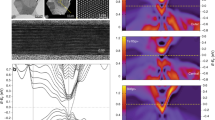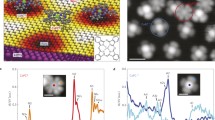Abstract
The Kondo effect1 is usually connected with the interaction between a localized spin moment and itinerant electrons. This interaction leads to the formation of a narrow resonance at the Fermi level, which is called the Abrikosov–Suhl or Kondo resonance2. Scanning tunnelling microscopy is an ideal technique for real-space investigations of complicated electronic structures3,4 and many-body phenomena, such as the formation of the Kondo resonance5,6,7,8 or d-wave pairing in high-Tc superconductors9. Theory has predicted that similar, Kondo-like many-electron resonances are possible for scattering centres with orbital instead of spin degrees of freedom—the quadruple momenta in uranium-based compounds or two-level systems in metallic glasses are examples of such ‘pseudo-Kondo’ scattering centres10. Here we present evidence for the orbital Kondo resonance on a transition-metal surface. Investigations of an atomically clean Cr(001) surface at low temperature using scanning tunnelling microscopy reveal a very narrow resonance at 26 meV above the Fermi level, and enable us to visualize the orbital character of the corresponding state. The experimental data, together with many-body calculations, demonstrate that the observed resonance is an orbital Kondo resonance formed by two degenerate dxz, dyz surface states.



Similar content being viewed by others
References
Kondo, J. Resistance minimum in dilute magnetic alloys. Prog. Theor. Phys. 32, 37–49 (1964).
Hewson, A. C. The Kondo Problem to Heavy Fermions (Cambridge Univ. Press, Cambridge, 1993).
Stroscio, J. A., Pierce, D. T., Davies, A., Celotta, R. J. & Weinert, M. Tunneling spectroscopy of bcc (001) surface states. Phys. Rev. Lett. 75, 2960–2963 (1996).
Heinze, S. et al. Real space imaging of two-dimensional antiferromagnetism on the atomic scale. Science 288, 1805–1808 (2000).
Madhavan, V., Chen, W., Jamneala, T., Crommie, M. F. & Wingreen, N. S. Tunneling into a single magnetic atom. Science 280, 567–569 (1998).
Manoharan, H. C., Lutz, C. P. & Eigler, D. M. Quantum mirages formed by coherent projection of electronic structure. Nature 403, 512–515 (2000).
Li, J., Schneider, W.-D., Berndt, R. & Delley, D. Kondo scattering observed at a single magnetic impurity. Phys. Rev. Lett. 80, 2893–2896 (1998).
Odom, T. W., Huang, J.-L., Cheung, C. L. & Lieber, C. M. Magnetic clusters on single-walled carbon nanotubes: the Kondo effect in a one-dimensional host. Science 290, 1549–1552 (2000).
Pan, S. H. et al. Imaging the effects of individual zinc impurity atoms on superconductivity in Bi2Sr2CaCu2O8+δ. Nature 403, 746–750 (2000).
Cox, D. L. & Zawadowski, A. Exotic Kondo effects in metals: magnetic ions in a crystalline electric field and tunneling centers. Adv. Phys. 47, 599–942 (1998).
van der Wielen, M. C. M. M., van Roij, A. J. A. & van Kempen, H. Direct observation of Friedel oscillations around Incorporated SiGa dopants in GaAs by low-temperature scanning tunneling microscopy. Phys. Rev. Lett. 76, 1075–1078 (1996).
Balatsky, A. V. Superconductivity: from obscurity to impurity. Nature 403, 717–718 (2000).
Crommie, M. F., Luts, C. P. & Eigler, D. M. Imaging standing waves in a two-dimensional electron gas. Nature 363, 524–527 (1993).
Schmid, M., Pinczolits, M., Hebenstreit, W. & Varga, P. Segregation of impurities on Cr(001) studied by AES and STM. Surf. Sci. 377, 1023–1027 (1997).
Fu, C. L. & Freeman, A. J. Surface ferromagnetism of Cr(001). Phys. Rev. B 33, 1755–1761 (1986).
Klebanoff, L. E., Victora, R. H., Falicov, L. M. & Shirley, D. A. Experimental and theoretical investigations of Cr(001) surface electronic structure. Phys. Rev. B 32, 1997–2005 (1985).
Kleiber, M., Bode, M., Ravlic, R. & Wiesendanger, R. Topology-induced spin frustration at the Cr(001) surface studied by spin-polarized scanning tunneling spectroscopy. Phys. Rev. Lett. 85, 4606–4609 (2000).
Georges, A., Kotliar, G., Krauth, W. & Rozenberg, M. Dynamical mean-field theory of strongly correlated fermion systems and the limit of infinite dimensions. Rev. Mod. Phys. 68, 13–125 (1996).
Jarrell, M. Symmetrical periodic Anderson model in infinite dimensions. Phys. Rev. B 51, 7429–7440 (1995).
Acknowledgements
We thank J. Hermsen and J. Gerritsen for technical assistance, and A. Keen for a reading of the manuscript. This work was supported by FOM and NWO.
Author information
Authors and Affiliations
Rights and permissions
About this article
Cite this article
Kolesnychenko, O., de Kort, R., Katsnelson, M. et al. Real-space imaging of an orbital Kondo resonance on the Cr(001) surface. Nature 415, 507–509 (2002). https://doi.org/10.1038/415507a
Received:
Accepted:
Issue Date:
DOI: https://doi.org/10.1038/415507a
- Springer Nature Limited
This article is cited by
-
Real-space observation of incommensurate spin density wave and coexisting charge density wave on Cr (001) surface
Nature Communications (2022)
-
Orbital Kondo effect in carbon nanotubes
Nature (2005)





